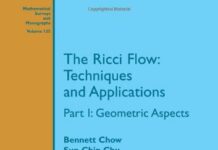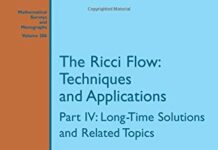
Ebook Info
- Published: 2006
- Number of pages: 608 pages
- Format: PDF
- File Size: 40.63 MB
- Authors: Bennett Chow
Description
Ricci flow is a powerful analytic method for studying the geometry and topology of manifolds. This book is an introduction to Ricci flow for graduate students and mathematicians interested in working in the subject. To this end, the first chapter is a review of the relevant basics of Riemannian geometry. For the benefit of the student, the text includes a number of exercises of varying difficulty. The book also provides brief introductions to some general methods of geometric analysis and other geometric flows. Comparisons are made between the Ricci flow and the linear heat equation, mean curvature flow, and other geometric evolution equations whenever possible. Several topics of Hamilton’s program are covered, such as short time existence, Harnack inequalities, Ricci solitons, Perelman’s no local collapsing theorem, singularity analysis, and ancient solutions. A major direction in Ricci flow, via Hamilton’s and Perelman’s works, is the use of Ricci flow as an approach to solving the Poincaré conjecture and Thurston’s geometrization conjecture.
User’s Reviews
Editorial Reviews: Review The style of the book is very pleasant, including lots of motivations and background material, course outlines and exercises (with solutions), the bibliography is rather comprehensive. This work is certain to become one of the main references in this field of great current interest. –M. KunzingerThis book is a very well written introduction to and resource for study of the Ricci flow. It is quite self-contained, but relevant references are provided at appropriate points. The style of the book renders it accessible to graduate students (suggested course outlines and many relevant further references are provided), while its substance provides an essential resource for background, key concepts and fundamental ideas for further study in the area. –James McCoy, Mathematical Reviews
Reviews from Amazon users which were colected at the time this book was published on the website:
⭐Dear AsianBooks +God’s peace to you.Thanks so mush for your sincere services!I am glad to buy the great book from such a excellent book store!I want to buy another soon,if I can! +God’s blessings to you all! +With praises and thanks to God.2011.12.19. Toshiaki Norikura
⭐Ricci Flow is one of the most advanced instruments we have for understanding Riemannian geometry, and–as a consequence–the topology of smooth manifolds. After all, the prodigious Perelman used it not only to prove the century-old Poincare conjecture, but to provide a kind of classification of 3-dimensional manifolds. Hamilton himself, who invented Ricci Flow, used it to show the following. If a compact manifold has a Riemannian metric of positive Ricci curvature, then (volume normalized) Ricci flow will smooth it out more and more as time progresses. As time goes to infinity, the geometry will actually converge exponentially fast to one of constant positive sectional curvature. In other words, if the manifold is simply-connected, Ricci flow will smooth it out to the usual 3-sphere. This book devotes an entire chapter to this proof.This book is aimed at graduate students like myself, and so it reviews the elements of Riemannian geometry. But this is done in such a way that everything gears you up for study of the Ricci Flow. It looks at results from different angles, so for example Bonnet-Myers is proved using variations of energy, but also by foliating the manifold into spheres about a point, using the distance function. Petersen’s Riemannian geometry book does the latter, and is very informative, but the writing is so tedious and technical and uninspired that it’s impossible to learn from (in my opinion). So I’m already recommending this book not just as a manual on Ricci Flow, but on the basic Riemannian geometry.The basics of Ricci Flow are introduced in such a way that you don’t realize you’re facing this powerful new method. You go over some calculus of variations–analyzing curves of Riemannian metrics. The formulas hold for arbitrary variations, and this seems hard but not impossible. Then–bam! One substitutes the Ricci curvature term for the variations, and the formulas become downright elegant. This first phase of learning, then, which is analogous to taking cough medicine, is actually made enjoyable by the good writing of the book, akin to a syrup which gives the medicine the taste of creme brulee.When unfamiliar formulas are introduced, everything that led to them is included in the book, down to elements that everyone should know. The authors know that students are always shaky on some particular topics (Lie derivatives, Ricci commutation formulas, change of geometric quantities under diffeomorphism), so these are mercifully included and repeated making the text truly self-contained. Ideas from analysis are obviously important for the study of this differential equation, but the authors are aware that geometers will be deficient in this area, so they include the important points. Administering a dash of care in this manner is what makes for a superlative book.What can I say? I haven’t gotten that far in the book. But I can say that many topics that would leap to a student’s mind are included, not just the standard fare. For instance, Ricci Flow is famously used on three-manifolds. But dimensions two and three are actually quite simple in the sense that knowledge of only the Ricci curvature will determine the whole Riemannian curvature tensor. So if one cares to seriously study, say, Einstein manifolds (constant Ricci curvature), one should adopt higher-dimensional techniques.Indeed, there is a chapter on higher-dimensional Ricci flow. Even special perks one gets in four dimesions (direct sum decomposition of two-forms into eigenspaces of the Hodge star) are treated. Another natural question is, what if a manifold is noncompact? Is completeness, for example, preserved? Noncompact Ricci flow is given a treatment. Lie groups are examined. Even other kinds of geometric flows are continually juxtaposed with the Ricci flow. References to pop culture are made.To wrap it up, maybe the subject of Ricci Flow is so elegant that any decently written work on the topic cannot fail to be good. [People say, for instance, that Hamlet can’t be performed badly.] But I don’t think either of those assertions are true, so I believe this work is a masterpiece.
⭐I’ve been reading up on Ricci flow lately, so I came across this book. While the topics covered in this book are clearly very interesting, this book sometimes feels too much like a cut-and-paste job. A good part of the material in this book is taken straight from the original research articles. Not much additional explanation is given. Sometimes the book contains typos that are not present in the original papers. This may not be much of an issue for a reader who pretty much knows the material, but for a beginner it is kind of annoying.
Keywords
Free Download Hamilton’s Ricci Flow (Graduate Studies in Mathematics) in PDF format
Hamilton’s Ricci Flow (Graduate Studies in Mathematics) PDF Free Download
Download Hamilton’s Ricci Flow (Graduate Studies in Mathematics) 2006 PDF Free
Hamilton’s Ricci Flow (Graduate Studies in Mathematics) 2006 PDF Free Download
Download Hamilton’s Ricci Flow (Graduate Studies in Mathematics) PDF
Free Download Ebook Hamilton’s Ricci Flow (Graduate Studies in Mathematics)


